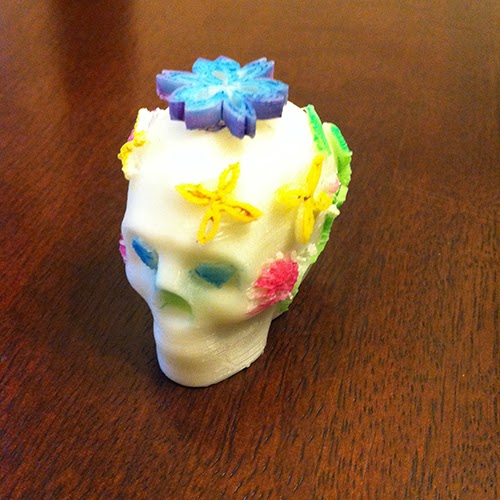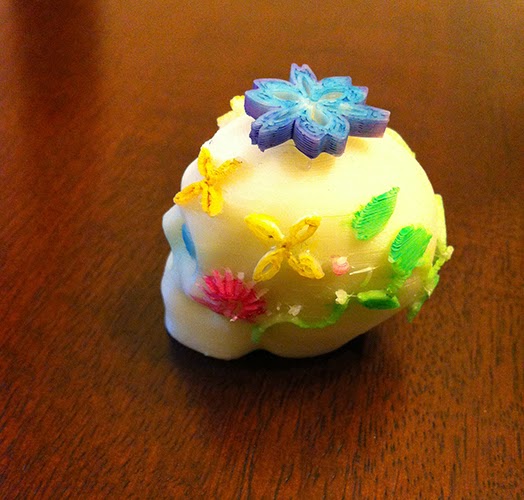This past Saturday was the wrap up showcase at the MLK Library for the Pop-Up Mobile Makerspace project. I created a Blurb book in collaboration with the San José Public Library to document our journey of the project. The Pop-Up Mobile Makerspace was an exploration in how to engage a wide range of San José citizens in new ways to discuss urban public space design, while creating a platform that enlivened underutilized public spaces.
We hope that the ideas shared by the public in this project will help inform the shaping of downtown San José public spaces so that these spaces truly invite people to linger, connect and engage. We hope that these experimental pop-up mobile makerspaces become a model for other groups to invite the public into urban planning discussions. The photos in this book capture some of the energy and creativity of the San José public who joined us on this journey. We are eager to see this conversation continue.
Here is a link to the book:
Thursday, November 12, 2015
Future Engineers Design Challenge Winner
Emily was selected as the Future Engineers Design Challenge Winner for the Junior Category (K-12 years old) in early October 2015. The 3D print design challenge was to design a space container for zero gravity. She created a tea cage that would brew tea grown on the ISS. Here is the announcement posted by ASME.
This is her statement for the project:
"Sometimes it gets boring in space. Astronauts need something to liven up their meals. After looking at the categories for a space container I decided to make a container for liquids. In space liquids form spheres and stick to things they touch because surface tension is different in zero gravity. While doing research I saw a video from space of some string holding a sphere of water in place. I realized a cage could definitely do it, too. I was reading about juices and tea. That got my mind working. Tea is flavored by leaves and astronauts study plants in space. Astronauts could plant tea leaves in space and occasionally they could pick a couple leaves and make tea! You put the tea leaves in the lower compartment of this design. The lid closes on hinges so the leaves don’t float away. You use Velcro to keep the lid closed. Then you squirt hot water into the cage. The water sphere would just stay in the cage. The leaves flavor the water through the holes and then you drink the tea!"
This is her statement for the project:
"Sometimes it gets boring in space. Astronauts need something to liven up their meals. After looking at the categories for a space container I decided to make a container for liquids. In space liquids form spheres and stick to things they touch because surface tension is different in zero gravity. While doing research I saw a video from space of some string holding a sphere of water in place. I realized a cage could definitely do it, too. I was reading about juices and tea. That got my mind working. Tea is flavored by leaves and astronauts study plants in space. Astronauts could plant tea leaves in space and occasionally they could pick a couple leaves and make tea! You put the tea leaves in the lower compartment of this design. The lid closes on hinges so the leaves don’t float away. You use Velcro to keep the lid closed. Then you squirt hot water into the cage. The water sphere would just stay in the cage. The leaves flavor the water through the holes and then you drink the tea!"
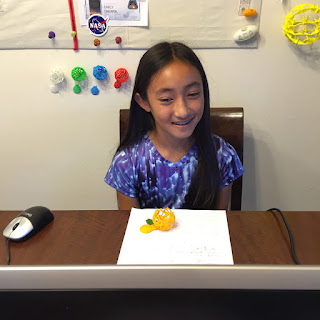 | |||
| Emily being interviewed in a google hangout by NASA engineers, Made In Space engineer, and an astronaut. |
| test 3D print |
| Emily's Tinkercad design work in progress. |
| initial concept sketches |
Tuesday, April 14, 2015
Future Engineers Youth 3D Design Challenge
The Future Engineer Design Challenge created by NASA and ASME was a great journey for many K-12 students this past fall/winter. A new challenge will be launching this spring.
All the designs submitted can be seen in the site's gallery page. The site is very well organized to inspire youth and to engage them in a design thinking journey as they imagine a useful zero gravity space tool to be 3D printed in space.
Many schools participate in this design journey. I have created a collaborative doc to capture the various work flows classes used to engage in the project. I am hoping more teachers add their experiences to the doc.
When I have engaged students and teachers in exploring this project, I have created cardboard volume forms for them to hold so that they know the maximum print size of the tool they will be designing. While the low resolution prototypes do not have to be 5cm x 10cm x 5cm, designers need to imagine that their final tool will be 3D printed at that size. Here are the design guidelines for this challenge.
All the designs submitted can be seen in the site's gallery page. The site is very well organized to inspire youth and to engage them in a design thinking journey as they imagine a useful zero gravity space tool to be 3D printed in space.
 |
| Samples of 5th grade student concept designs in low resolution prototypes and iterated as CAD models. |
When I have engaged students and teachers in exploring this project, I have created cardboard volume forms for them to hold so that they know the maximum print size of the tool they will be designing. While the low resolution prototypes do not have to be 5cm x 10cm x 5cm, designers need to imagine that their final tool will be 3D printed at that size. Here are the design guidelines for this challenge.
| Volume forms representing the 3D print size constraint of 5cm x 10cm x 5cm |
Stratasys 3D Extreme Redesign Challenge
A week or so ago, we learned that both Cole and Emily are finalists in the Art & Architecture strand of the Stratasys 3D Extreme Redesign Challenge. This 3D CAD design challenge is a great opportunity for youth to participate in and feel a part of a broader community of young makers globally. For this particular youth challenge, 3D prints are not required for submission. A .stl file, a few screen shots of the CAD design, and a written statement regarding the design are the requirements.
Below is Cole's design. He used free CAD tools to design it. He used Sculptris to create a few if the more organic volume forms, Illustrator to create the insect limbs (exporting as .svg files) and then brought the pieces together in Tinkercad to assemble and design the final piece. He reduced the file size of the Sculptris pieces in Meshmixer before importing into Tinkercad. He printed the piece using the UV cured acrylic plastic frosted detail 3D printing method through Shapeways
Emily also used Sculptris in her workflow. She created the feet, head, and tail of her design in Sculptris. She reduced the file size by reducing the triangles of the mesh in Meshmixer. and then imported the parts into Tinkercad where she completed the piece.
Below is Cole's design. He used free CAD tools to design it. He used Sculptris to create a few if the more organic volume forms, Illustrator to create the insect limbs (exporting as .svg files) and then brought the pieces together in Tinkercad to assemble and design the final piece. He reduced the file size of the Sculptris pieces in Meshmixer before importing into Tinkercad. He printed the piece using the UV cured acrylic plastic frosted detail 3D printing method through Shapeways
 |
| Cole's "Insect Plate" printed by Shapeways |
 |
| Cole wearing his Extreme Redesign T-shirt in front of his school. |
 |
| Emily's "Bumbuku the Badger Tea Kettle" |
 |
| Emily with the 3D print of her badger tea kettle in front of her school. |
Thursday, October 16, 2014
3D Printed Dia de los Muertos Calaveras
Today the 3D printed skulls designed in the teen workshops were installed at the Dr. Roberto Cruz Library. Additional photo can be seen at this online album. Here is the Instructables posting.
It was nice that the skulls went up next to a Dia de los Muertos alter created by moms of students at Escuela Popular.
I created a digital textile that captured screen grabs of all the 3D designs in Tinkercad.
Each teen and the few adults who participated created a statement about their design and who it honored.
It was nice that the skulls went up next to a Dia de los Muertos alter created by moms of students at Escuela Popular.
I created a digital textile that captured screen grabs of all the 3D designs in Tinkercad.
Each teen and the few adults who participated created a statement about their design and who it honored.
Friday, October 10, 2014
Lingraphica, a visual vocabulary for Aphasics
Today my sister asked me about my first job out of college creating visuals for a program called Lingraphica for suffers of Aphasia. Aphasia is a disturbance of the comprehension and expression of language caused by dysfunction in the brain. I Googled "Lingraphica" and was surprised to see that it now a series of iPhone apps!
This really interesting project was led by Hal Rucker and was my introduction to working with a small design team in creating software. The project was for Richard D. Steele, PhD. who was developing Lingraphica at Stanford.
In this job, I learned Illustrator, Photoshop, and an animation technique as we created a library of imagery for Aphasics to use. I learned so much on the job and really appreciate the fun experience of collaboration with Hal and the steep learning curve I went through. The actions library was particularly fun as we created simple animations to express verb concepts. I see that the animated verbs today are the same ones I helped to create with Rucker Design back in 1990. It is so cool to see this video on the product and to see that it has grown and is still being used as a communication and therapy tool.
Here are Hal's thoughts on this project when I shared this posting with him today. I had asked him what software we used for the animations. I knew that we video recorded a mime from which we then traced frame grabs!
"Wow. Yes, that was an intense and amazing project. And so impressive to see the same artwork from 1989 is still in use. Looks like they added color to our old b&w drawings. (When we did this project laptops didn't have color screens.) Corey, to answer your questions about the verbs: We videotaped mimes doing the motions, grabbed them frame by frame using Director, saved off each frame and brought it into Photoshop and hand traced each video frame. As a final step we converted the bitmaps for the screen to vector art for their print work. An early version of digital rotoscoping. I still have all the files! Here's the image we did for their t-shirt for their first trade show" - Hal Rucker
 |
| A screen grab of a few of the animated verb images I created with Rucker Design for the initial version of Lingraphica. These ares still being used many years later in the updated version of the app. |
This really interesting project was led by Hal Rucker and was my introduction to working with a small design team in creating software. The project was for Richard D. Steele, PhD. who was developing Lingraphica at Stanford.
In this job, I learned Illustrator, Photoshop, and an animation technique as we created a library of imagery for Aphasics to use. I learned so much on the job and really appreciate the fun experience of collaboration with Hal and the steep learning curve I went through. The actions library was particularly fun as we created simple animations to express verb concepts. I see that the animated verbs today are the same ones I helped to create with Rucker Design back in 1990. It is so cool to see this video on the product and to see that it has grown and is still being used as a communication and therapy tool.
 |
| First Lingraphica trade show T-shirt. Image curtsey of Hal Rucker. |
"Wow. Yes, that was an intense and amazing project. And so impressive to see the same artwork from 1989 is still in use. Looks like they added color to our old b&w drawings. (When we did this project laptops didn't have color screens.) Corey, to answer your questions about the verbs: We videotaped mimes doing the motions, grabbed them frame by frame using Director, saved off each frame and brought it into Photoshop and hand traced each video frame. As a final step we converted the bitmaps for the screen to vector art for their print work. An early version of digital rotoscoping. I still have all the files! Here's the image we did for their t-shirt for their first trade show" - Hal Rucker
Tuesday, September 30, 2014
Teen 3D Printing Calaveras de Azucar workshops in East San Jose
| Three teen designed calaveras de azucar printed in glow-in-dark-filament |
Their written statements will be displayed in the library installation along with their 3D prints. I am printed the designs on my Afinia printer and the Sunnyvale Library is helping me by printing five of the calaveras. The skull we are using is here on Tinkercad. All the students' designs are in Tinkercad under hashtag #sugarskull. The lesson plan can be found here at this link and on my Instructable posting.
I dreamed up this project a year ago after attend my first 3D printing conference and purchasing a used 3D printer off of Craigslist. A few weeks ago, Afinia posted a blog story on my short journey in 3D printing.
 |
| A student explores negative shapes in Tinkercad as he builds his calavera honoring family members. |
| Print hot off the printer with supports still on. |
| Some of the participants in the first workshop in the computer lab. |
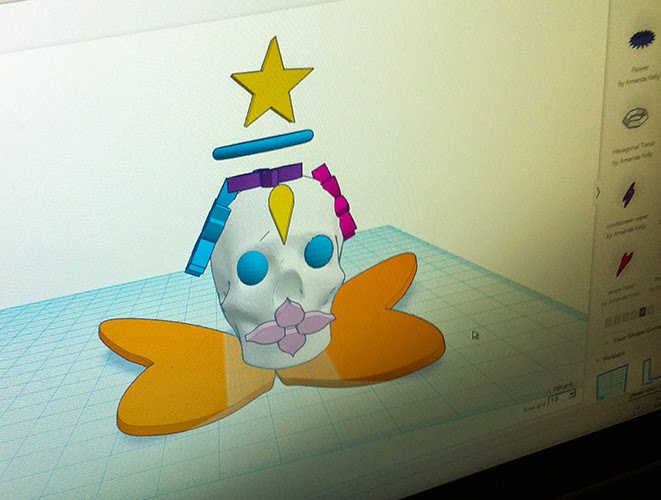 |
| A student builds her design to honor her grandmother. |
| An early print fail. |
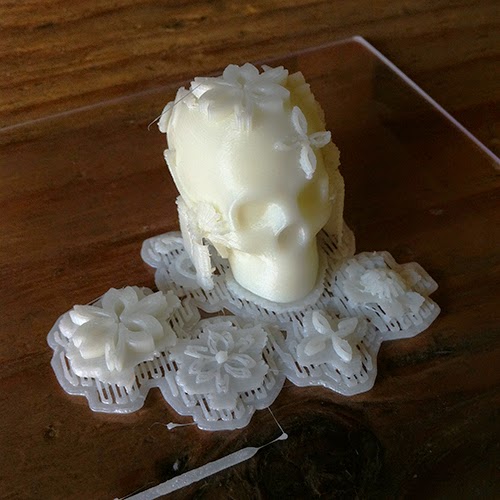 | |
| A sample skull design printed in glow-in-the-dark filament |
Subscribe to:
Posts (Atom)



